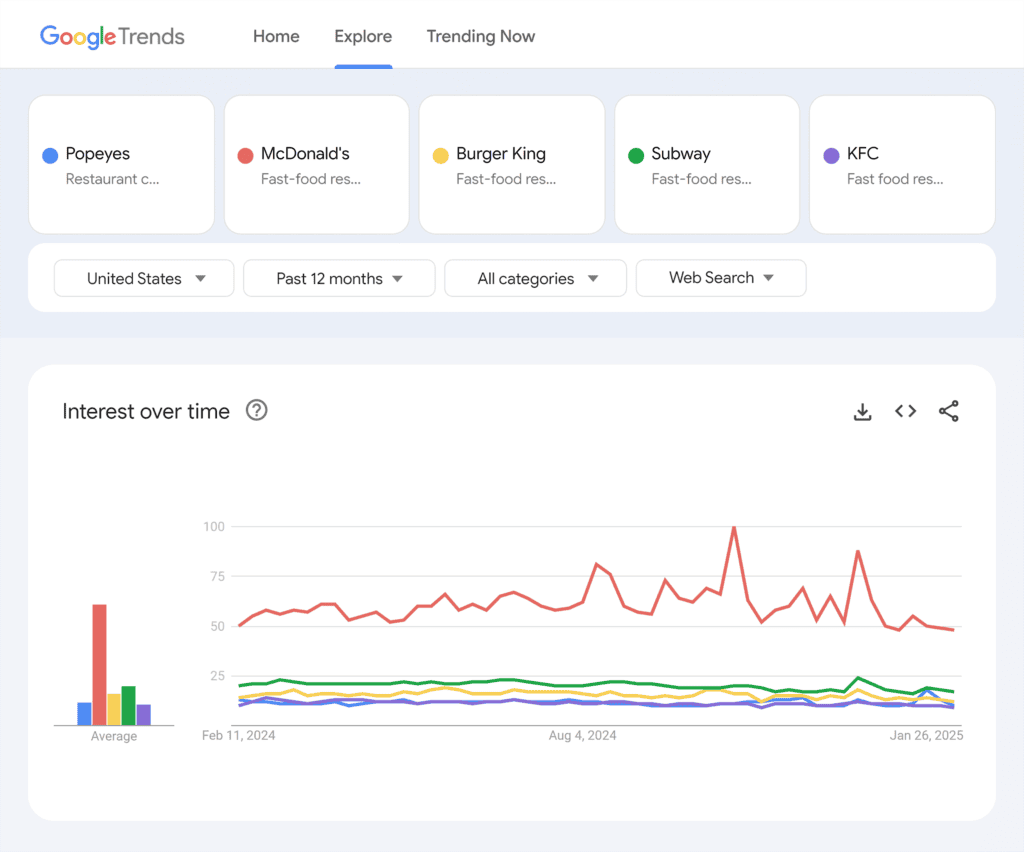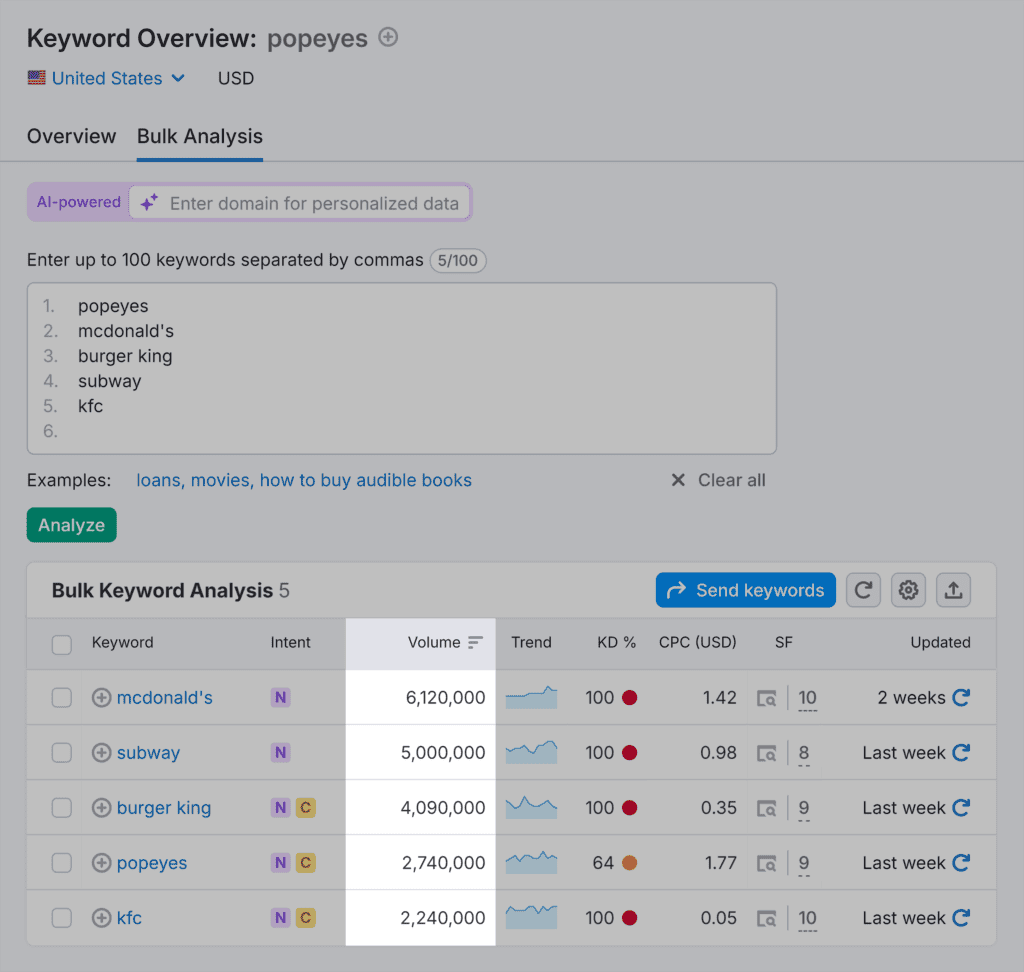
If people search for your client’s brand online, there’s a high chance they’re looking for something specific to buy. After all, significant search interest means potentially higher sales.
But how do you evaluate users’ search interest in your brand compared to other competing brands? You can do it by measuring share of search.
In this article, I’ll explain the concept of share of search. I’ll also teach you how to measure it and improve a brand’s performance in organic search results — ultimately leading to better search engine rankings.
What Is Share of Search?
Share of search is a marketing metric that measures how visible your brand is in organic search results compared to other brands in the same segment.
Les Binet, an expert in econometrics, refers to share of search as the share of organic search queries for a particular brand divided by the total branded searches in that category.
Binet also states there’s a strong correlation between share of search and market share. It means brands doing well in organic search results typically make higher revenue.
Let me give you an example. Suppose the keyword “running shoes” has a monthly global volume of 100. If your brand appears 20 times in organic search results for this keyword, then your share of search is 20%.
I used the following formula in my example above.

But don’t worry — you won’t need to calculate it manually. In the next paragraph, I’ll show you two methods for measuring and calculating share of search for your brand.
How to Calculate Share of Search
Manually calculating the aggregated search volume is a lot of work. Instead, I recommend using Google Trends or Semrush to estimate share of search.
These tools can help you assess how many searches occur monthly for your target keywords and which searches include your brand name.
Let’s take a look at each one in a little more detail.
Google Trends
Google Trends is a free tool that you can use to analyze the popularity of search queries over time.
If you know your organic competitors, you can easily compare share of search for up to five branded keywords.
To do so, open Google Trends. Now, add your and your competitors’ branded keywords one by one. Google Trends will show you search interest over time, where 100 is the peak popularity for a search query.
If you want to learn advanced Google Trends tips, check out this TTT course on “How to Use Google Trends for SEO.”

In my example, McDonald’s is the winner based on users’ search interests. However, that’s only an estimate of monthly organic search traffic.
You can calculate share of search by dividing your branded organic traffic by aggregated organic search traffic. I prefer using Excel for calculations and chart creation, but you can use any other software.
It seems McDonald’s has dominated the organic search market in the past 12 months.

Analyzing share of search using Google Trends is a quick and easy process. However, the tool has several limitations for SEO and SEM worth noting.
For example, Google Trends mainly provides data on branded searches for established websites. If you run a new website or your website’s monthly traffic is relatively low, Google Trends won’t show any data.
Moreover, you can only compare up to five keywords at a time. If you want to analyze more keywords, Google Trends isn’t the right tool.
Last but not least, you can’t assess how your website performs compared to your organic rivals for non-branded searches. That’s because Google Trends can only show search interest for your branded keywords.
If you want to conduct more in-depth and accurate research, I recommend using SEO tools like Semrush.
Semrush
Semrush is an all-in-one digital marketing toolkit with multiple features for advanced keyword research, website technical audit, backlink analysis, paid advertising, and more.
You can use Semrush Keyword Overview to replicate the data from Google Trends. Unlike Google Trends, Semrush’s data is way more accurate.
Plug your and competitors’ branded keywords into the Bulk Analysis and hit “Analyze.” Semrush will show you the average monthly searches for your keywords over the past 12 months.

If you divide your branded keywords’ search volume by the aggregated search volume, you’ll get a way more accurate estimation of share of search.
In my example, McDonald’s clearly dominates share of search. However, the numbers slightly differ from Google Trends’ data.

You can also use Position Tracking in Semrush to track the search engine visibility metric. The Competitors Discovery tab within Position Tracking shows how well your website ranks in organic search engine results compared to your rivals.
If search visibility is close to 0 percent, it means your competitors don’t rank for your target keywords. However, if their visibility share is bigger than yours, it’s a sign for you to pay closer attention to their on-page and off-page SEO.
There’s one more thing you should know about share of search before analyzing this metric for your brand.
The share of search metric doesn’t accurately represent your overall marketing efforts. This metric depends on monthly volumes, which may increase or decrease for various reasons.
For example, seasonality, trends, or events can cause a spike in share of search. It doesn’t necessarily mean your SEO efforts contributed to success.
There’s another way to measure a brand’s performance across multiple marketing channels. Let’s look at this method next.
Share of Search vs. Share of Voice
Website owners often confuse these metrics, but I assure you they are different.
Share of voice is a marketing metric that compares your brand awareness against your competitors. It considers all media types, including paid advertising, social media, and offline marketing.
Imagine you’re at a party where everyone is talking about different topics. The brand with the highest share of voice is the one that gets mentioned the most. It’s the brand that’s on everyone’s minds.
Share of voice measures your brand’s overall presence in the market. On the other hand, share of search provides insights into how easily your brand can be found in organic search results.
Even though more than 44% of customers start their journeys in search engines, some may find your website through online marketplaces. Therefore, measuring both metrics will give you a more accurate assessment of the performance of your marketing activities.
Wondering How to Supercharge Your SEO Skills?
Share of search is just one metric to evaluate your website’s performance compared to your rivals. However, many aspects impact a website’s performance in organic search results, including keyword selection, backlinks, on-page SEO, and many more.
So, if you need some help improving your website’s performance but don’t know where to start, check out TTT Academy. It’s a go-to resource for SEOs and agency owners, who want to level up their skills.
Equipped with tips from 40+ SEO experts, live Q&A sessions, and an exclusive SEO community, you’ll never feel stuck in SEO again.
You can go at your own pace through our courses, which include 200+ hours of lessons. They’ll help you gain in-depth knowledge about topics such as keyword research, analytics and reporting, link building, technical SEO, affiliate marketing, and SEO for SaaS.
To discover SEO practices that actually work, learn more about joining TTT Academy today!